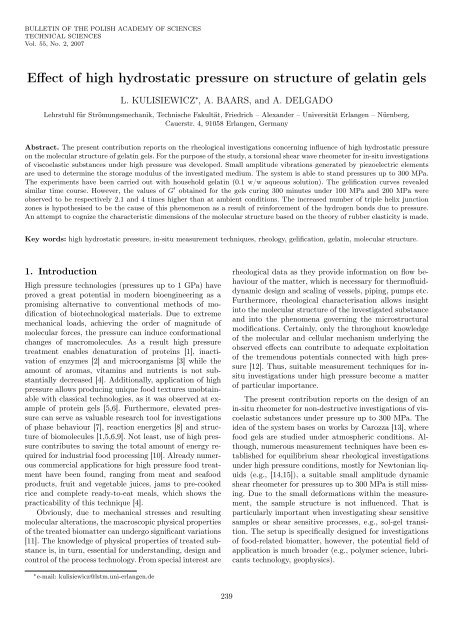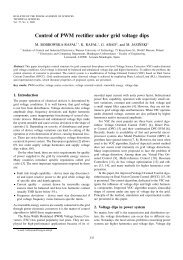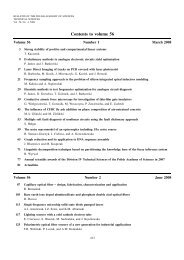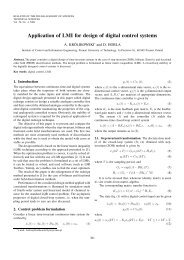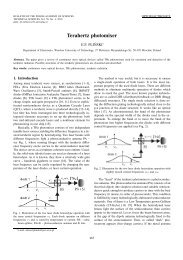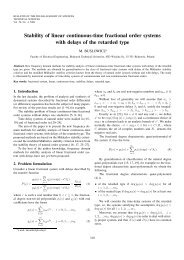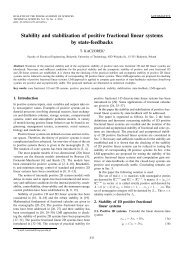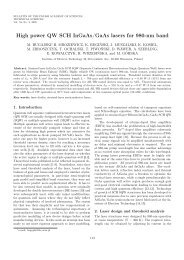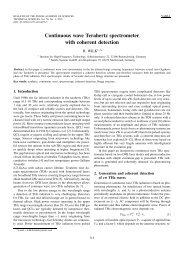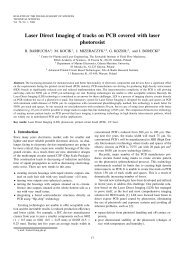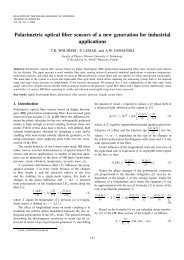Effect of high hydrostatic pressure on structure of gelatin gels
Effect of high hydrostatic pressure on structure of gelatin gels
Effect of high hydrostatic pressure on structure of gelatin gels
Create successful ePaper yourself
Turn your PDF publications into a flip-book with our unique Google optimized e-Paper software.
BULLETIN OF THE POLISH ACADEMY OF SCIENCES<br />
TECHNICAL SCIENCES<br />
Vol. 55, No. 2, 2007<br />
<str<strong>on</strong>g>Effect</str<strong>on</strong>g> <str<strong>on</strong>g>of</str<strong>on</strong>g> <str<strong>on</strong>g>high</str<strong>on</strong>g> <str<strong>on</strong>g>hydrostatic</str<strong>on</strong>g> <str<strong>on</strong>g>pressure</str<strong>on</strong>g> <strong>on</strong> <strong>structure</strong> <str<strong>on</strong>g>of</str<strong>on</strong>g> <strong>gelatin</strong> <strong>gels</strong><br />
L. KULISIEWICZ ∗ , A. BAARS, and A. DELGADO<br />
Lehrstuhl für Strömungsmechanik, Technische Fakultät, Friedrich – Alexander – Universität Erlangen – Nürnberg,<br />
Cauerstr. 4, 91058 Erlangen, Germany<br />
Abstract. The present c<strong>on</strong>tributi<strong>on</strong> reports <strong>on</strong> the rheological investigati<strong>on</strong>s c<strong>on</strong>cerning influence <str<strong>on</strong>g>of</str<strong>on</strong>g> <str<strong>on</strong>g>high</str<strong>on</strong>g> <str<strong>on</strong>g>hydrostatic</str<strong>on</strong>g> <str<strong>on</strong>g>pressure</str<strong>on</strong>g><br />
<strong>on</strong> the molecular <strong>structure</strong> <str<strong>on</strong>g>of</str<strong>on</strong>g> <strong>gelatin</strong> <strong>gels</strong>. For the purpose <str<strong>on</strong>g>of</str<strong>on</strong>g> the study, a torsi<strong>on</strong>al shear wave rheometer for in-situ investigati<strong>on</strong>s<br />
<str<strong>on</strong>g>of</str<strong>on</strong>g> viscoelastic substances under <str<strong>on</strong>g>high</str<strong>on</strong>g> <str<strong>on</strong>g>pressure</str<strong>on</strong>g> was developed. Small amplitude vibrati<strong>on</strong>s generated by piezoelectric elements<br />
are used to determine the storage modulus <str<strong>on</strong>g>of</str<strong>on</strong>g> the investigated medium. The system is able to stand <str<strong>on</strong>g>pressure</str<strong>on</strong>g>s up to 300 MPa.<br />
The experiments have been carried out with household <strong>gelatin</strong> (0.1 w/w aqueous soluti<strong>on</strong>). The gelificati<strong>on</strong> curves revealed<br />
similar time course. However, the values <str<strong>on</strong>g>of</str<strong>on</strong>g> G ′ obtained for the <strong>gels</strong> curing 300 minutes under 100 MPa and 200 MPa were<br />
observed to be respectively 2.1 and 4 times <str<strong>on</strong>g>high</str<strong>on</strong>g>er than at ambient c<strong>on</strong>diti<strong>on</strong>s. The increased number <str<strong>on</strong>g>of</str<strong>on</strong>g> triple helix juncti<strong>on</strong><br />
z<strong>on</strong>es is hypothesised to be the cause <str<strong>on</strong>g>of</str<strong>on</strong>g> this phenomen<strong>on</strong> as a result <str<strong>on</strong>g>of</str<strong>on</strong>g> reinforcement <str<strong>on</strong>g>of</str<strong>on</strong>g> the hydrogen b<strong>on</strong>ds due to <str<strong>on</strong>g>pressure</str<strong>on</strong>g>.<br />
An attempt to cognize the characteristic dimensi<strong>on</strong>s <str<strong>on</strong>g>of</str<strong>on</strong>g> the molecular <strong>structure</strong> based <strong>on</strong> the theory <str<strong>on</strong>g>of</str<strong>on</strong>g> rubber elasticity is made.<br />
Key words: <str<strong>on</strong>g>high</str<strong>on</strong>g> <str<strong>on</strong>g>hydrostatic</str<strong>on</strong>g> <str<strong>on</strong>g>pressure</str<strong>on</strong>g>, in-situ measurement techniques, rheology, gelificati<strong>on</strong>, <strong>gelatin</strong>, molecular <strong>structure</strong>.<br />
1. Introducti<strong>on</strong><br />
High <str<strong>on</strong>g>pressure</str<strong>on</strong>g> technologies (<str<strong>on</strong>g>pressure</str<strong>on</strong>g>s up to 1 GPa) have<br />
proved a great potential in modern bioengineering as a<br />
promising alternative to c<strong>on</strong>venti<strong>on</strong>al methods <str<strong>on</strong>g>of</str<strong>on</strong>g> modificati<strong>on</strong><br />
<str<strong>on</strong>g>of</str<strong>on</strong>g> biotechnological materials. Due to extreme<br />
mechanical loads, achieving the order <str<strong>on</strong>g>of</str<strong>on</strong>g> magnitude <str<strong>on</strong>g>of</str<strong>on</strong>g><br />
molecular forces, the <str<strong>on</strong>g>pressure</str<strong>on</strong>g> can induce c<strong>on</strong>formati<strong>on</strong>al<br />
changes <str<strong>on</strong>g>of</str<strong>on</strong>g> macromolecules. As a result <str<strong>on</strong>g>high</str<strong>on</strong>g> <str<strong>on</strong>g>pressure</str<strong>on</strong>g><br />
treatment enables denaturati<strong>on</strong> <str<strong>on</strong>g>of</str<strong>on</strong>g> proteins [1], inactivati<strong>on</strong><br />
<str<strong>on</strong>g>of</str<strong>on</strong>g> enzymes [2] and microorganisms [3] while the<br />
amount <str<strong>on</strong>g>of</str<strong>on</strong>g> aromas, vitamins and nutrients is not substantially<br />
decreased [4]. Additi<strong>on</strong>ally, applicati<strong>on</strong> <str<strong>on</strong>g>of</str<strong>on</strong>g> <str<strong>on</strong>g>high</str<strong>on</strong>g><br />
<str<strong>on</strong>g>pressure</str<strong>on</strong>g> allows producing unique food textures unobtainable<br />
with classical technologies, as it was observed at example<br />
<str<strong>on</strong>g>of</str<strong>on</strong>g> protein <strong>gels</strong> [5,6]. Furthermore, elevated <str<strong>on</strong>g>pressure</str<strong>on</strong>g><br />
can serve as valuable research tool for investigati<strong>on</strong>s<br />
<str<strong>on</strong>g>of</str<strong>on</strong>g> phase behaviour [7], reacti<strong>on</strong> energetics [8] and <strong>structure</strong><br />
<str<strong>on</strong>g>of</str<strong>on</strong>g> biomolecules [1,5,6,9]. Not least, use <str<strong>on</strong>g>of</str<strong>on</strong>g> <str<strong>on</strong>g>high</str<strong>on</strong>g> <str<strong>on</strong>g>pressure</str<strong>on</strong>g><br />
c<strong>on</strong>tributes to saving the total amount <str<strong>on</strong>g>of</str<strong>on</strong>g> energy required<br />
for industrial food processing [10]. Already numerous<br />
commercial applicati<strong>on</strong>s for <str<strong>on</strong>g>high</str<strong>on</strong>g> <str<strong>on</strong>g>pressure</str<strong>on</strong>g> food treatment<br />
have been found, ranging from meat and seafood<br />
products, fruit and vegetable juices, jams to pre-cooked<br />
rice and complete ready-to-eat meals, which shows the<br />
practicability <str<strong>on</strong>g>of</str<strong>on</strong>g> this technique [4].<br />
Obviously, due to mechanical stresses and resulting<br />
molecular alterati<strong>on</strong>s, the macroscopic physical properties<br />
<str<strong>on</strong>g>of</str<strong>on</strong>g> the treated biomatter can undergo significant variati<strong>on</strong>s<br />
[11]. The knowledge <str<strong>on</strong>g>of</str<strong>on</strong>g> physical properties <str<strong>on</strong>g>of</str<strong>on</strong>g> treated substance<br />
is, in turn, essential for understanding, design and<br />
c<strong>on</strong>trol <str<strong>on</strong>g>of</str<strong>on</strong>g> the process technology. From special interest are<br />
∗ e-mail: kulisiewicz@lstm.uni-erlangen.de<br />
239<br />
rheological data as they provide informati<strong>on</strong> <strong>on</strong> flow behaviour<br />
<str<strong>on</strong>g>of</str<strong>on</strong>g> the matter, which is necessary for therm<str<strong>on</strong>g>of</str<strong>on</strong>g>luiddynamic<br />
design and scaling <str<strong>on</strong>g>of</str<strong>on</strong>g> vessels, piping, pumps etc.<br />
Furthermore, rheological characterisati<strong>on</strong> allows insight<br />
into the molecular <strong>structure</strong> <str<strong>on</strong>g>of</str<strong>on</strong>g> the investigated substance<br />
and into the phenomena governing the microstructural<br />
modificati<strong>on</strong>s. Certainly, <strong>on</strong>ly the throughout knowledge<br />
<str<strong>on</strong>g>of</str<strong>on</strong>g> the molecular and cellular mechanism underlying the<br />
observed effects can c<strong>on</strong>tribute to adequate exploitati<strong>on</strong><br />
<str<strong>on</strong>g>of</str<strong>on</strong>g> the tremendous potentials c<strong>on</strong>nected with <str<strong>on</strong>g>high</str<strong>on</strong>g> <str<strong>on</strong>g>pressure</str<strong>on</strong>g><br />
[12]. Thus, suitable measurement techniques for insitu<br />
investigati<strong>on</strong>s under <str<strong>on</strong>g>high</str<strong>on</strong>g> <str<strong>on</strong>g>pressure</str<strong>on</strong>g> become a matter<br />
<str<strong>on</strong>g>of</str<strong>on</strong>g> particular importance.<br />
The present c<strong>on</strong>tributi<strong>on</strong> reports <strong>on</strong> the design <str<strong>on</strong>g>of</str<strong>on</strong>g> an<br />
in-situ rheometer for n<strong>on</strong>-destructive investigati<strong>on</strong>s <str<strong>on</strong>g>of</str<strong>on</strong>g> viscoelastic<br />
substances under <str<strong>on</strong>g>pressure</str<strong>on</strong>g> up to 300 MPa. The<br />
idea <str<strong>on</strong>g>of</str<strong>on</strong>g> the system bases <strong>on</strong> works by Carozza [13], where<br />
food <strong>gels</strong> are studied under atmospheric c<strong>on</strong>diti<strong>on</strong>s. Although,<br />
numerous measurement techniques have been established<br />
for equilibrium shear rheological investigati<strong>on</strong>s<br />
under <str<strong>on</strong>g>high</str<strong>on</strong>g> <str<strong>on</strong>g>pressure</str<strong>on</strong>g> c<strong>on</strong>diti<strong>on</strong>s, mostly for Newt<strong>on</strong>ian liquids<br />
(e.g., [14,15]), a suitable small amplitude dynamic<br />
shear rheometer for <str<strong>on</strong>g>pressure</str<strong>on</strong>g>s up to 300 MPa is still missing.<br />
Due to the small deformati<strong>on</strong>s within the measurement,<br />
the sample <strong>structure</strong> is not influenced. That is<br />
particularly important when investigating shear sensitive<br />
samples or shear sensitive processes, e.g., sol-gel transiti<strong>on</strong>.<br />
The setup is specifically designed for investigati<strong>on</strong>s<br />
<str<strong>on</strong>g>of</str<strong>on</strong>g> food-related biomatter, however, the potential field <str<strong>on</strong>g>of</str<strong>on</strong>g><br />
applicati<strong>on</strong> is much broader (e.g., polymer science, lubricants<br />
technology, geophysics).
Numerous food systems, for which <str<strong>on</strong>g>high</str<strong>on</strong>g> <str<strong>on</strong>g>pressure</str<strong>on</strong>g> technology<br />
might potentially bring significant advantages [4],<br />
feature viscoelastic behaviour (e.g., jams, fruit jellies,<br />
pastes, creams, yoghurt). A prevalent comp<strong>on</strong>ent <str<strong>on</strong>g>of</str<strong>on</strong>g> those<br />
foodstuffs is <strong>gelatin</strong>. This animal origin protein is used as<br />
a gelling agent, stabiliser, thickener and texturizer [16].<br />
Gelatin plays an important role in producti<strong>on</strong> <str<strong>on</strong>g>of</str<strong>on</strong>g> foods<br />
with reduced fat c<strong>on</strong>tent to simulate the mouth feel <str<strong>on</strong>g>of</str<strong>on</strong>g> fat<br />
without extensive calories. Therefore, due to <str<strong>on</strong>g>high</str<strong>on</strong>g> practical<br />
importance, household <strong>gelatin</strong> was chosen for current<br />
study.<br />
2. Materials and methods<br />
2.1. Theory. C<strong>on</strong>sidering viscoelastic sample between<br />
two plates within the linear regime [17], the storage and<br />
loss modulus are calculated by<br />
G ′ ρω<br />
=<br />
2<br />
G ′′ =<br />
( 4π 2<br />
λ 2 − 1<br />
( 4π 2<br />
λ 2 + 1<br />
z 2 0<br />
z 2 0<br />
)<br />
L. Kulisiewicz, A. Baars, and A. Delgado<br />
) 2 , (1)<br />
4π ρω2 λz0<br />
(<br />
4π2 λ2 + 1<br />
z2 ) 2 , (2)<br />
0<br />
where ρ represents the sample density, ω the angular frequency<br />
<str<strong>on</strong>g>of</str<strong>on</strong>g> plate vibrati<strong>on</strong>, λ the wave length and z0 the<br />
exp<strong>on</strong>ential damping length. By introducti<strong>on</strong> <str<strong>on</strong>g>of</str<strong>on</strong>g> the dimensi<strong>on</strong>less<br />
wave length<br />
and the wave velocity<br />
s = λ<br />
2πz0<br />
c = ωλ<br />
2π<br />
equati<strong>on</strong>s (1) and (2) can be transformed to<br />
G ′ = ρc<br />
2 1 − s2<br />
(3)<br />
(4)<br />
(1 + s2 2 , (5)<br />
)<br />
G ′′ = ρc 2 2s<br />
(1 + s2 2 . (6)<br />
)<br />
In this case the loss tangent, being the ratio G ′′ /G ′ , equals<br />
tan δ = 2s<br />
. (7)<br />
1 − s2 The dimensi<strong>on</strong>less wave length s can be calculated from<br />
equati<strong>on</strong> (7) for known values <str<strong>on</strong>g>of</str<strong>on</strong>g> the loss tangent. C<strong>on</strong>sequently,<br />
storage and loss modulus may be determined<br />
by measurement <str<strong>on</strong>g>of</str<strong>on</strong>g> the wave velocity c and by the loss<br />
tangent tan δ for known sample density ρ.<br />
In linear viscoelastic medium between two plates,<br />
where <strong>on</strong>e undergoes forced harm<strong>on</strong>ic displacement, res<strong>on</strong>ances<br />
can occur as the frequency ω is varied. It can be<br />
shown [17] that<br />
tan δ = ω2 − ω1<br />
, (8)<br />
ω0<br />
where ω0 is the res<strong>on</strong>ant frequency. The values ω1 and ω2<br />
name the frequencies at which the energy absorbed from<br />
the oscillator reaches half <str<strong>on</strong>g>of</str<strong>on</strong>g> its maximum value. This is<br />
equivalent to points at which the amplitude <str<strong>on</strong>g>of</str<strong>on</strong>g> the oscillati<strong>on</strong><br />
decreases by the factor 1/ √ 2. Thus, the loss tangent<br />
can be determined by applicati<strong>on</strong> <str<strong>on</strong>g>of</str<strong>on</strong>g> harm<strong>on</strong>ic oscillati<strong>on</strong>s<br />
to <strong>on</strong>e <str<strong>on</strong>g>of</str<strong>on</strong>g> the sensor plates and measurement <str<strong>on</strong>g>of</str<strong>on</strong>g> the amplitude<br />
at the sec<strong>on</strong>d plate as the frequency <str<strong>on</strong>g>of</str<strong>on</strong>g> oscillati<strong>on</strong><br />
is varied. The result <strong>on</strong>ly applies if the loss tangent is<br />
treated as being independent <str<strong>on</strong>g>of</str<strong>on</strong>g> frequency. In practice it<br />
is c<strong>on</strong>sidered as valid if (ω2 − ω1) is small in comparis<strong>on</strong><br />
with ω0. The wave velocity c can be determined from the<br />
time <str<strong>on</strong>g>of</str<strong>on</strong>g> flight that the disturbance travels from <strong>on</strong>e sensor<br />
plate to the other. Thus, storage and loss moduli can be<br />
calculated according to Eqs. (5) and (6). It is worth c<strong>on</strong>sidering,<br />
that for the case <str<strong>on</strong>g>of</str<strong>on</strong>g> an ideally elastic solid, where<br />
the wave is not attenuated z0 is infinite, and the Eq. (1)<br />
changes to<br />
G ′ = ρc 2 . (9)<br />
Similarly, for a predominantly elastic material, as the <strong>gels</strong><br />
investigated in the present work, where λ is much smaller<br />
than z0 calculati<strong>on</strong> <str<strong>on</strong>g>of</str<strong>on</strong>g> the storage modulus with Eq. (9)<br />
leads to <strong>on</strong>ly a marginal error [17].<br />
2.2. Measurement setup. The sample fills the gap between<br />
two parallel plates <str<strong>on</strong>g>of</str<strong>on</strong>g> 23 mm diameter (see 2 in<br />
Fig. 1). Each plate is c<strong>on</strong>nected with a piezoelectric element<br />
– <strong>on</strong>e working as a driver, the other as a sensor.<br />
Piezoelectric elements are manufactured as composites <str<strong>on</strong>g>of</str<strong>on</strong>g><br />
plumbum-zirc<strong>on</strong>ate-titanate and carb<strong>on</strong> fibres in a polymeric<br />
coating. Hence, under driving voltage they undergo<br />
torsi<strong>on</strong>al oscillati<strong>on</strong>s. In this way, small amplitude torsi<strong>on</strong>al<br />
shear waves are applied to the sample.<br />
Fig. 1. High <str<strong>on</strong>g>pressure</str<strong>on</strong>g> torsi<strong>on</strong>al shear wave rheometer. 1-c<strong>on</strong>tracting sample chamber, 2-sensor/sender plates, 3-termocouple,<br />
4-piezo element shielding<br />
240 Bull. Pol. Ac.: Tech. 55(2) 2007
<str<strong>on</strong>g>Effect</str<strong>on</strong>g> <str<strong>on</strong>g>of</str<strong>on</strong>g> <str<strong>on</strong>g>high</str<strong>on</strong>g> <str<strong>on</strong>g>hydrostatic</str<strong>on</strong>g> <str<strong>on</strong>g>pressure</str<strong>on</strong>g> <strong>on</strong> <strong>structure</strong> <str<strong>on</strong>g>of</str<strong>on</strong>g> <strong>gelatin</strong> <strong>gels</strong><br />
The measurement system is placed in a <str<strong>on</strong>g>high</str<strong>on</strong>g> <str<strong>on</strong>g>pressure</str<strong>on</strong>g><br />
cell capable to hold <str<strong>on</strong>g>pressure</str<strong>on</strong>g>s up to 300 MPa. Water is<br />
used as a <str<strong>on</strong>g>pressure</str<strong>on</strong>g> transmitting fluid. The temperature <str<strong>on</strong>g>of</str<strong>on</strong>g><br />
the <str<strong>on</strong>g>pressure</str<strong>on</strong>g> chamber is set by means <str<strong>on</strong>g>of</str<strong>on</strong>g> a c<strong>on</strong>trolled thermal<br />
bath. The temperature inside the sample chamber<br />
can be gauged by a thermocouple.<br />
In order to determine the storage modulus from Eq.<br />
(9), the measurement <str<strong>on</strong>g>of</str<strong>on</strong>g> the time <str<strong>on</strong>g>of</str<strong>on</strong>g> flight τ, a disturbance<br />
travels between driver and sensor plates is used to assess<br />
the wave velocity. The distance between the plates h is<br />
set in the range <str<strong>on</strong>g>of</str<strong>on</strong>g> 0.3 to 1 mm. Thence, the wave velocity<br />
equals<br />
c = h<br />
, (10)<br />
τ − τ0<br />
where τ0 is the effective resp<strong>on</strong>se time <str<strong>on</strong>g>of</str<strong>on</strong>g> the instrument.<br />
The value <str<strong>on</strong>g>of</str<strong>on</strong>g> τ0 is determined by calibrati<strong>on</strong>. For<br />
this purpose, a comparative measurement is carried out<br />
under atmospheric <str<strong>on</strong>g>pressure</str<strong>on</strong>g> by means <str<strong>on</strong>g>of</str<strong>on</strong>g> a dynamic stress<br />
rheometer (Rheometric Scientific SR-5000).<br />
However, due to compressi<strong>on</strong>-induced change <str<strong>on</strong>g>of</str<strong>on</strong>g> the<br />
mechanical properties <str<strong>on</strong>g>of</str<strong>on</strong>g> materials used for the c<strong>on</strong>structi<strong>on</strong><br />
<str<strong>on</strong>g>of</str<strong>on</strong>g> the experimental setup, particularly <str<strong>on</strong>g>of</str<strong>on</strong>g> the polymeric<br />
materials applied in the piezoelectric composites,<br />
the dynamic characteristics <str<strong>on</strong>g>of</str<strong>on</strong>g> the system changes with<br />
<str<strong>on</strong>g>pressure</str<strong>on</strong>g>. Therefore, the effective resp<strong>on</strong>se time <str<strong>on</strong>g>of</str<strong>on</strong>g> the instrument<br />
is a functi<strong>on</strong> <str<strong>on</strong>g>of</str<strong>on</strong>g> <str<strong>on</strong>g>pressure</str<strong>on</strong>g>. In order to determine<br />
the change <str<strong>on</strong>g>of</str<strong>on</strong>g> resp<strong>on</strong>se time, both piezoelectric composites<br />
were c<strong>on</strong>nected with a brass stalk and the resp<strong>on</strong>se<br />
time was measured at different <str<strong>on</strong>g>pressure</str<strong>on</strong>g> levels. The determined<br />
<str<strong>on</strong>g>pressure</str<strong>on</strong>g> correcti<strong>on</strong> for the resp<strong>on</strong>se time is negative,<br />
i.e., the resp<strong>on</strong>se time decreases with <str<strong>on</strong>g>pressure</str<strong>on</strong>g> due<br />
to compressi<strong>on</strong>-induced stiffening <str<strong>on</strong>g>of</str<strong>on</strong>g> the mechanical elements.<br />
2.3. Sample preparati<strong>on</strong> and experimental procedure.<br />
Gelatin soluti<strong>on</strong> is used as a model system for the<br />
current investigati<strong>on</strong>s. The sample is prepared according<br />
to the method given in [18] as a 0.1 w/w household <strong>gelatin</strong><br />
aqueous soluti<strong>on</strong>.<br />
Prior to the measurement, the calibrati<strong>on</strong> procedure<br />
is carried out in order to determine τ0 (see Eq. 9). The<br />
course <str<strong>on</strong>g>of</str<strong>on</strong>g> storage modulus G ′ over time during gelificati<strong>on</strong><br />
by cooling <str<strong>on</strong>g>of</str<strong>on</strong>g> the soluti<strong>on</strong> from 40 ◦ C to 20 ◦ C is tracked in<br />
the <str<strong>on</strong>g>high</str<strong>on</strong>g> <str<strong>on</strong>g>pressure</str<strong>on</strong>g> rheometer and dynamic stress rheometer<br />
with c<strong>on</strong>e-and-plate geometry at 1 Hz. After 300 minutes<br />
<str<strong>on</strong>g>of</str<strong>on</strong>g> measurement the results are compared and the<br />
effective resp<strong>on</strong>se time is determined.<br />
However, at this stage, special attenti<strong>on</strong> must be<br />
paid to the frequency spectrum <str<strong>on</strong>g>of</str<strong>on</strong>g> the storage modulus.<br />
Namely, it must be proven that the storage modulus is<br />
independent <str<strong>on</strong>g>of</str<strong>on</strong>g> frequency in the frequency range used.<br />
Otherwise, the measurement at 1 Hz by dynamic stress<br />
rheometer and the measurement at <str<strong>on</strong>g>high</str<strong>on</strong>g> <str<strong>on</strong>g>pressure</str<strong>on</strong>g> rheometer,<br />
which typically takes place at the frequency <str<strong>on</strong>g>of</str<strong>on</strong>g> several<br />
hundred Hz could not be compared. Thus, the frequency<br />
spectrum for the storage modulus <str<strong>on</strong>g>of</str<strong>on</strong>g> the investigated sample<br />
is measured firstly in order to prove the applicability <str<strong>on</strong>g>of</str<strong>on</strong>g><br />
the measurement system for the aimed investigati<strong>on</strong>. This<br />
preparatory experiment carried out for 0.1 w/w aqueous<br />
<strong>gelatin</strong> soluti<strong>on</strong> showed that the storage modulus can be<br />
treated as frequency independent in the interesting frequency<br />
range.<br />
After the calibrati<strong>on</strong> procedure the measurement<br />
setup is heated up to 40 ◦ C and kept at that temperature<br />
for several hours in order to ensure the complete reversi<strong>on</strong><br />
<str<strong>on</strong>g>of</str<strong>on</strong>g> the gelificati<strong>on</strong> process. Next, the rheometer is placed<br />
inside the <str<strong>on</strong>g>pressure</str<strong>on</strong>g> cell and the <str<strong>on</strong>g>pressure</str<strong>on</strong>g> is increased up<br />
to 100 MPa. Having the <str<strong>on</strong>g>pressure</str<strong>on</strong>g> increased, the sample<br />
is held at 40 ◦ C for 30 minutes in order to equilibrate the<br />
temperature inhomogeneities developed due to polytropic<br />
compressi<strong>on</strong>. Afterwards, the temperature <str<strong>on</strong>g>of</str<strong>on</strong>g> the thermal<br />
bath is set to 20 ◦ C. Due to large thermal inertia <str<strong>on</strong>g>of</str<strong>on</strong>g> the<br />
<str<strong>on</strong>g>pressure</str<strong>on</strong>g> chamber, it takes around 25 minutes until the<br />
quench temperature <str<strong>on</strong>g>of</str<strong>on</strong>g> 20 ◦ C is reached inside the chamber.<br />
The measurement is being carried out for 300 minutes<br />
and the temperature is increased again up to 40 ◦ C.<br />
The chamber is held at that temperature for several hours<br />
and afterwards the <str<strong>on</strong>g>pressure</str<strong>on</strong>g> is increased up to 200 MPa.<br />
After the equilibrati<strong>on</strong> time the temperature is decreased<br />
again to 20 ◦ C and the measurement is started. The course<br />
<str<strong>on</strong>g>of</str<strong>on</strong>g> temperature and <str<strong>on</strong>g>pressure</str<strong>on</strong>g> is schematically depicted in<br />
Fig. 2.<br />
Fig. 2. The course <str<strong>on</strong>g>of</str<strong>on</strong>g> temperature and <str<strong>on</strong>g>pressure</str<strong>on</strong>g> during experiment.<br />
The periods <str<strong>on</strong>g>of</str<strong>on</strong>g> data registrati<strong>on</strong> during gel building are<br />
marked grey<br />
The density <str<strong>on</strong>g>of</str<strong>on</strong>g> the sample necessary for the calculati<strong>on</strong><br />
<str<strong>on</strong>g>of</str<strong>on</strong>g> the storage modulus G ′ (see Eq. 9) is determined using<br />
the following approach. Firstly, the difference between the<br />
measured density <str<strong>on</strong>g>of</str<strong>on</strong>g> 0.1 w/w aqueous <strong>gelatin</strong> soluti<strong>on</strong> and<br />
that <str<strong>on</strong>g>of</str<strong>on</strong>g> pure water is calculated at ambient <str<strong>on</strong>g>pressure</str<strong>on</strong>g>. An<br />
assumpti<strong>on</strong> is made that this <str<strong>on</strong>g>of</str<strong>on</strong>g>fset remains c<strong>on</strong>stant in<br />
the investigated <str<strong>on</strong>g>pressure</str<strong>on</strong>g> range. Thus, the density <str<strong>on</strong>g>of</str<strong>on</strong>g> the<br />
sample under <str<strong>on</strong>g>high</str<strong>on</strong>g> <str<strong>on</strong>g>pressure</str<strong>on</strong>g> is calculated as the density<br />
<str<strong>on</strong>g>of</str<strong>on</strong>g> water under <str<strong>on</strong>g>high</str<strong>on</strong>g> <str<strong>on</strong>g>pressure</str<strong>on</strong>g> (according to [20]) increased<br />
by the determined <str<strong>on</strong>g>of</str<strong>on</strong>g>fset.<br />
Bull. Pol. Ac.: Tech. 55(2) 2007 241
3. Results and discussi<strong>on</strong><br />
The measurements carried out at 100 and 200 MPa reveal<br />
that <strong>gelatin</strong> has kept its jellifying properties under <str<strong>on</strong>g>high</str<strong>on</strong>g><br />
<str<strong>on</strong>g>pressure</str<strong>on</strong>g>. The development <str<strong>on</strong>g>of</str<strong>on</strong>g> the storage modulus G ′ over<br />
time is depicted in Fig. 3. The time is referred to the total<br />
measurement time tend and the storage modulus to the<br />
value at t = tend. The measurement at atmospheric <str<strong>on</strong>g>pressure</str<strong>on</strong>g><br />
and comparative measurement with dynamic stress<br />
rheometer Rheometric Scientific SR-5000 used for means<br />
<str<strong>on</strong>g>of</str<strong>on</strong>g> calibrati<strong>on</strong> are shown as well.<br />
Fig. 3. Development <str<strong>on</strong>g>of</str<strong>on</strong>g> the storage modulus G ′ over time during<br />
gelificati<strong>on</strong> <str<strong>on</strong>g>of</str<strong>on</strong>g> <strong>gelatin</strong>e (after Ref. 19)<br />
The storage modulus at the end <str<strong>on</strong>g>of</str<strong>on</strong>g> experiment at ambient<br />
<str<strong>on</strong>g>pressure</str<strong>on</strong>g> equals to 3.8 kPa, at 100 MPa reaches 8 kPa<br />
and 15 kPa at 200 MPa. This correlates with the ex-situ<br />
investigati<strong>on</strong>s by M<strong>on</strong>tero et al. [21], who have observed<br />
the <strong>gelatin</strong> <str<strong>on</strong>g>of</str<strong>on</strong>g> cod and megrim skin cured under <str<strong>on</strong>g>pressure</str<strong>on</strong>g>s<br />
up to 400 MPa to reveal c<strong>on</strong>siderably <str<strong>on</strong>g>high</str<strong>on</strong>g>er values <str<strong>on</strong>g>of</str<strong>on</strong>g> the<br />
storage modulus G’ up<strong>on</strong> melting in comparis<strong>on</strong> to n<strong>on</strong>pressurized<br />
reference probe. However, the authors point<br />
out str<strong>on</strong>g variati<strong>on</strong> <str<strong>on</strong>g>of</str<strong>on</strong>g> the <strong>gelatin</strong> gel properties in respect<br />
<str<strong>on</strong>g>of</str<strong>on</strong>g> the animal species, the extracti<strong>on</strong> method and<br />
the <str<strong>on</strong>g>pressure</str<strong>on</strong>g>-temperature trajectory during gelificati<strong>on</strong>.<br />
Gelatin is a biopolymer made from collagen through<br />
hydrolysis process. The native collagen units are rods <str<strong>on</strong>g>of</str<strong>on</strong>g><br />
300 nm length, each <strong>on</strong>e built <str<strong>on</strong>g>of</str<strong>on</strong>g> 3 amino acid strands<br />
<str<strong>on</strong>g>of</str<strong>on</strong>g> molecular weight <str<strong>on</strong>g>of</str<strong>on</strong>g> 100 000. The three strands have a<br />
form <str<strong>on</strong>g>of</str<strong>on</strong>g> a triple helix, where single chains are c<strong>on</strong>nected by<br />
hydrogen b<strong>on</strong>ds perpendicular to the chain axes. Gelatin,<br />
being denaturated collagen, above melting temperature<br />
exhibits flexible random coil c<strong>on</strong>formati<strong>on</strong>. In the literature<br />
there is an agreement [9,16,18] that up<strong>on</strong> cooling<br />
the <strong>gelatin</strong> undergoes c<strong>on</strong>formati<strong>on</strong>al change, where parts<br />
<str<strong>on</strong>g>of</str<strong>on</strong>g> the molecular chain transform into helix. At the helix<br />
sites the molecular strands c<strong>on</strong>nect with other strands<br />
being in helix c<strong>on</strong>formati<strong>on</strong>. As a result, juncti<strong>on</strong> z<strong>on</strong>es<br />
develop, which resemble the <strong>on</strong>es <str<strong>on</strong>g>of</str<strong>on</strong>g> the native collagen.<br />
With time, the built gel network spans through the whole<br />
sample. However, the juncti<strong>on</strong> building process is understood<br />
to be completed in two steps: nucleati<strong>on</strong> and wrapping.<br />
The nucleati<strong>on</strong> process is in this case the rate limiting<br />
<strong>on</strong>e, since it requires positive activati<strong>on</strong> energy. The<br />
following process <str<strong>on</strong>g>of</str<strong>on</strong>g> wrapping the strands is thermodynamically<br />
favoured to be fast. The critical nucleus can<br />
further transform into helix juncti<strong>on</strong> z<strong>on</strong>e if it exceeds a<br />
certain critical length. This critical helix length increases<br />
L. Kulisiewicz, A. Baars, and A. Delgado<br />
with temperature and tends to infinity at gelati<strong>on</strong> point<br />
as shown by Guo [16]. Let us now c<strong>on</strong>sider the influence<br />
<str<strong>on</strong>g>of</str<strong>on</strong>g> <str<strong>on</strong>g>high</str<strong>on</strong>g> <str<strong>on</strong>g>pressure</str<strong>on</strong>g> <strong>on</strong> that limiting parameter. Since the helix<br />
juncti<strong>on</strong>s are stabilised by hydrogen b<strong>on</strong>ding, it seems<br />
valid that the stability <str<strong>on</strong>g>of</str<strong>on</strong>g> the hydrogen b<strong>on</strong>ds is the crucial<br />
factor influencing the critical helix length. C<strong>on</strong>sequently,<br />
it can be expected that the str<strong>on</strong>ger the hydrogen b<strong>on</strong>ds<br />
are, the shorter the critical helix nuclei must be. The hydrogen<br />
b<strong>on</strong>ds are known to be promoted under <str<strong>on</strong>g>high</str<strong>on</strong>g> <str<strong>on</strong>g>pressure</str<strong>on</strong>g><br />
due to their negative activati<strong>on</strong> volume [1]. Thus, it<br />
is postulated, that the stable length <str<strong>on</strong>g>of</str<strong>on</strong>g> the helix juncti<strong>on</strong><br />
z<strong>on</strong>e is shifted towards lower values at elevated <str<strong>on</strong>g>pressure</str<strong>on</strong>g>s<br />
and hence the gelificati<strong>on</strong> temperature is shifted to <str<strong>on</strong>g>high</str<strong>on</strong>g>er<br />
values.<br />
Due to inapplicability <str<strong>on</strong>g>of</str<strong>on</strong>g> the measurement <str<strong>on</strong>g>of</str<strong>on</strong>g> G ′ for<br />
determinati<strong>on</strong> <str<strong>on</strong>g>of</str<strong>on</strong>g> gel point it is difficult to recognize the<br />
changes in the gelificati<strong>on</strong> temperature within the present<br />
experiment. However, the earlier investigati<strong>on</strong>s <str<strong>on</strong>g>of</str<strong>on</strong>g> Shimada<br />
et al. [22] by means <str<strong>on</strong>g>of</str<strong>on</strong>g> hot-wire method as well as<br />
the study <str<strong>on</strong>g>of</str<strong>on</strong>g> Gekko and Fukamizu [9] with the falling ball<br />
method show indeed a remarkable increase <str<strong>on</strong>g>of</str<strong>on</strong>g> gelificati<strong>on</strong><br />
temperature up<strong>on</strong> pressurizati<strong>on</strong> by 2÷3 K per 100 MPa.<br />
The rheological experiment carried out within the<br />
present c<strong>on</strong>tributi<strong>on</strong> indicates <str<strong>on</strong>g>high</str<strong>on</strong>g>er values <str<strong>on</strong>g>of</str<strong>on</strong>g> the storage<br />
modulus for the <strong>gels</strong> cured at elevated <str<strong>on</strong>g>pressure</str<strong>on</strong>g>s. This<br />
allows a statement that the average length <str<strong>on</strong>g>of</str<strong>on</strong>g> the parts<br />
<str<strong>on</strong>g>of</str<strong>on</strong>g> the molecular chain remaining in random coil c<strong>on</strong>formati<strong>on</strong><br />
is shorter. Thus, either the triple helix juncti<strong>on</strong><br />
z<strong>on</strong>es in the <strong>gelatin</strong> gel cured under <str<strong>on</strong>g>high</str<strong>on</strong>g> <str<strong>on</strong>g>pressure</str<strong>on</strong>g> are<br />
l<strong>on</strong>ger than at ambient <str<strong>on</strong>g>pressure</str<strong>on</strong>g>, or they are shorter but<br />
more numerous. Taking into account the c<strong>on</strong>siderati<strong>on</strong>s<br />
presented above, it follows that the latter is true. This<br />
means that the <strong>gels</strong> cured under elevated <str<strong>on</strong>g>pressure</str<strong>on</strong>g>s exhibit<br />
more triple helix juncti<strong>on</strong> z<strong>on</strong>es per molecular chain<br />
compared to the <strong>gels</strong> cured at normal c<strong>on</strong>diti<strong>on</strong>s.<br />
By use <str<strong>on</strong>g>of</str<strong>on</strong>g> the thermodynamic theory <str<strong>on</strong>g>of</str<strong>on</strong>g> rubber elasticity<br />
(see for example [23,24]) it is possible to correlate the<br />
storage modulus G ′ and the average molecular weight <str<strong>on</strong>g>of</str<strong>on</strong>g><br />
the chain parts between the juncti<strong>on</strong>s M c. Including the<br />
correcti<strong>on</strong> for free ends (see [23]) the following relati<strong>on</strong><br />
applies<br />
( ′ G<br />
M c =<br />
uRT<br />
) −1<br />
2<br />
+ , (11)<br />
M<br />
where u is the c<strong>on</strong>centrati<strong>on</strong> <str<strong>on</strong>g>of</str<strong>on</strong>g> the dissolved polymer, R<br />
the universal gas c<strong>on</strong>stant, T the absolute temperature,<br />
and M the average molecular weight <str<strong>on</strong>g>of</str<strong>on</strong>g> the whole molecular<br />
chain. The average number <str<strong>on</strong>g>of</str<strong>on</strong>g> juncti<strong>on</strong>s per molecular<br />
chain n can be, hence, calculated<br />
n = M<br />
+ 1. (12)<br />
M c<br />
Applicati<strong>on</strong> <str<strong>on</strong>g>of</str<strong>on</strong>g> the theory <str<strong>on</strong>g>of</str<strong>on</strong>g> rubber elasticity to the<br />
experimentally acquired storage modulus after 100 minutes<br />
<str<strong>on</strong>g>of</str<strong>on</strong>g> gelling delivers the average number <str<strong>on</strong>g>of</str<strong>on</strong>g> juncti<strong>on</strong>s<br />
per molecular chain equal to 3.9 at ambient <str<strong>on</strong>g>pressure</str<strong>on</strong>g>, 4.8<br />
at 100 MPa and 6.4 at 200 MPa. The juncti<strong>on</strong>s are treated<br />
242 Bull. Pol. Ac.: Tech. 55(2) 2007
<str<strong>on</strong>g>Effect</str<strong>on</strong>g> <str<strong>on</strong>g>of</str<strong>on</strong>g> <str<strong>on</strong>g>high</str<strong>on</strong>g> <str<strong>on</strong>g>hydrostatic</str<strong>on</strong>g> <str<strong>on</strong>g>pressure</str<strong>on</strong>g> <strong>on</strong> <strong>structure</strong> <str<strong>on</strong>g>of</str<strong>on</strong>g> <strong>gelatin</strong> <strong>gels</strong><br />
here as point-wise, which is an approximati<strong>on</strong>. Specifically<br />
after l<strong>on</strong>ger curing the cross linking z<strong>on</strong>es can reach c<strong>on</strong>siderable<br />
length due to rewrapping processes. However,<br />
investigati<strong>on</strong>s presented in [9] and [16] reveal that the<br />
cross linking juncti<strong>on</strong> z<strong>on</strong>es <str<strong>on</strong>g>of</str<strong>on</strong>g> <strong>gelatin</strong> c<strong>on</strong>sist <str<strong>on</strong>g>of</str<strong>on</strong>g> rather a<br />
small size <str<strong>on</strong>g>of</str<strong>on</strong>g> triple helix <str<strong>on</strong>g>of</str<strong>on</strong>g> <strong>on</strong>ly few nm length, whilst the<br />
overall length <str<strong>on</strong>g>of</str<strong>on</strong>g> a <strong>gelatin</strong> molecule reaches ca. 300 nm.<br />
4. Summary<br />
A torsi<strong>on</strong>al shear wave rheometer for in-situ <str<strong>on</strong>g>high</str<strong>on</strong>g> <str<strong>on</strong>g>pressure</str<strong>on</strong>g><br />
investigati<strong>on</strong>s (up to 300 MPa) <str<strong>on</strong>g>of</str<strong>on</strong>g> viscoelastic substances<br />
has been developed. This measurement system uses transmissi<strong>on</strong><br />
<str<strong>on</strong>g>of</str<strong>on</strong>g> small amplitude torsi<strong>on</strong>al shear waves generated<br />
by piezoelectric elements to determine the storage<br />
and loss moduli.<br />
The measurements up<strong>on</strong> the gelificati<strong>on</strong> <str<strong>on</strong>g>of</str<strong>on</strong>g> 0.1 w/w<br />
<strong>gelatin</strong> aqueous soluti<strong>on</strong> under elevated <str<strong>on</strong>g>pressure</str<strong>on</strong>g> by<br />
quenching from 40 ◦ C to 20 ◦ C show that the <strong>gels</strong> achieved<br />
at <str<strong>on</strong>g>pressure</str<strong>on</strong>g>s <str<strong>on</strong>g>of</str<strong>on</strong>g> 100 and 200 MPa reveal values <str<strong>on</strong>g>of</str<strong>on</strong>g> the storage<br />
modulus <str<strong>on</strong>g>high</str<strong>on</strong>g>er by factor 2.1 and 4 respectively in<br />
comparis<strong>on</strong> to <strong>gels</strong> cured at ambient <str<strong>on</strong>g>pressure</str<strong>on</strong>g>. M<strong>on</strong>tero<br />
et al. [21] have observed similar phenomen<strong>on</strong> before with<br />
use <str<strong>on</strong>g>of</str<strong>on</strong>g> ex-situ methods. A hypothesis is presented that the<br />
<str<strong>on</strong>g>high</str<strong>on</strong>g>er values <str<strong>on</strong>g>of</str<strong>on</strong>g> the storage modulus originate from the<br />
increased number <str<strong>on</strong>g>of</str<strong>on</strong>g> triple helix juncti<strong>on</strong> z<strong>on</strong>es per molecular<br />
chain. It is postulated that the governing effect is the<br />
decrease <str<strong>on</strong>g>of</str<strong>on</strong>g> the critical length <str<strong>on</strong>g>of</str<strong>on</strong>g> helix nucleus preceding<br />
development <str<strong>on</strong>g>of</str<strong>on</strong>g> a triple helix juncti<strong>on</strong> z<strong>on</strong>e originating<br />
from the increased stability <str<strong>on</strong>g>of</str<strong>on</strong>g> the hydrogen b<strong>on</strong>ds due<br />
to <str<strong>on</strong>g>pressure</str<strong>on</strong>g>. The presented hypothesis seems to be c<strong>on</strong>sistent<br />
with the earlier works by Gekko and Fukamizu [9]<br />
and Shimada et al. [22] as well as investigati<strong>on</strong>s <str<strong>on</strong>g>of</str<strong>on</strong>g> <strong>gelatin</strong><br />
<strong>gels</strong> in deuterium oxide by Oakenfull and Scott [24]. The<br />
characteristic parameter <str<strong>on</strong>g>of</str<strong>on</strong>g> the gel network, i.e. number<br />
<str<strong>on</strong>g>of</str<strong>on</strong>g> juncti<strong>on</strong>s per molecular chain is calculated by use <str<strong>on</strong>g>of</str<strong>on</strong>g><br />
the theory <str<strong>on</strong>g>of</str<strong>on</strong>g> rubber elasticity [23]. After 100 minutes <str<strong>on</strong>g>of</str<strong>on</strong>g><br />
gel curing, the number <str<strong>on</strong>g>of</str<strong>on</strong>g> cross links per molecular chain<br />
amounts 3.9 at ambient <str<strong>on</strong>g>pressure</str<strong>on</strong>g>, 4.8 at 100 MPa and 6.4<br />
at 200 MPa.<br />
References<br />
[1] K. Heremans and L. Smeller, “Protein <strong>structure</strong> and dynamics<br />
at <str<strong>on</strong>g>high</str<strong>on</strong>g> <str<strong>on</strong>g>pressure</str<strong>on</strong>g>”, Biochimica et Biophysica Acta<br />
1386, 353–370 (1998).<br />
[2] R. Buckow, V. Heinz, and D. Knorr, “<str<strong>on</strong>g>Effect</str<strong>on</strong>g> <str<strong>on</strong>g>of</str<strong>on</strong>g> <str<strong>on</strong>g>high</str<strong>on</strong>g> <str<strong>on</strong>g>hydrostatic</str<strong>on</strong>g><br />
<str<strong>on</strong>g>pressure</str<strong>on</strong>g>-temperature combinati<strong>on</strong>s <strong>on</strong> the activity<br />
<str<strong>on</strong>g>of</str<strong>on</strong>g> ß-glucanase from barley malt”, J. Institute <str<strong>on</strong>g>of</str<strong>on</strong>g> Brewing<br />
111, 282–289 (2005).<br />
[3] K.V. Kilimann, C. Hartmann, A. Delgado, R.F. Vogel,<br />
and M.G. Gänzle, “A fuzzy logic based model for the<br />
multi-stage <str<strong>on</strong>g>high</str<strong>on</strong>g> <str<strong>on</strong>g>pressure</str<strong>on</strong>g> inactivati<strong>on</strong> <str<strong>on</strong>g>of</str<strong>on</strong>g> Lactococcus lactis<br />
ssp. cremoris MG 1363”, Int. J. Food Microbiology 98,<br />
89–105 (2005).<br />
[4] A. Suzuki, “High <str<strong>on</strong>g>pressure</str<strong>on</strong>g> processed foods in Japan and<br />
the world”, in: Trends in High Pressure Bioscience and<br />
Biotechnology, pp. 365–374, ed. R. Hayashi, Elsevier Science,<br />
Amsterdam, 2002.<br />
[5] J. Hinrichs, “Ultrahochdruckbehandlung v<strong>on</strong> Lebensmitteln<br />
mit Schwerpunkt Milch- und Milchprodukte –<br />
Phänomene, Kinetik und Methodik”, VDI-Fortschritt-<br />
Berichte 656, 3 (2000).<br />
[6] A. Baars, L. Kulisiewicz, R. Gebhardt, W. Doster, and A.<br />
Delgado, “Viscosity and aggregati<strong>on</strong> <str<strong>on</strong>g>of</str<strong>on</strong>g> beta-lactoglobulin<br />
under <str<strong>on</strong>g>high</str<strong>on</strong>g> <str<strong>on</strong>g>pressure</str<strong>on</strong>g>”, Proc. Int. Symposium <strong>on</strong> Food Rheology<br />
and Structure, Zurich, 263–267 (2006).<br />
[7] S.V. Kapranov, M. Pehl, C. Hartmann, A. Baars, and<br />
A. Delgado, “On the influence <str<strong>on</strong>g>of</str<strong>on</strong>g> <str<strong>on</strong>g>high</str<strong>on</strong>g> <str<strong>on</strong>g>pressure</str<strong>on</strong>g> <strong>on</strong> edible<br />
oils”, Proc. 2 nd Int. C<strong>on</strong>f. High Pressure Bioscience and<br />
Biotechnology 453 (6), (2002).<br />
[8] V. Stippl, A. Delgado, and T. Becker, “I<strong>on</strong>izati<strong>on</strong> equilibria<br />
at <str<strong>on</strong>g>high</str<strong>on</strong>g> <str<strong>on</strong>g>pressure</str<strong>on</strong>g>”, European Food Research Technology<br />
221, 151–156 (2005).<br />
[9] F. Gekko and M. Fukamizu, “<str<strong>on</strong>g>Effect</str<strong>on</strong>g> <str<strong>on</strong>g>of</str<strong>on</strong>g> <str<strong>on</strong>g>pressure</str<strong>on</strong>g> <strong>on</strong> the<br />
sol-gel transiti<strong>on</strong> <str<strong>on</strong>g>of</str<strong>on</strong>g> <strong>gelatin</strong>”, Int. J. Biological Macromolecules<br />
13, 295–300 (1991).<br />
[10] A. Baars, N. Pereyra, A. Delgado, D. Margosch, M.<br />
Ehrmann, R. Vogel, M. Czerny, P. Schieberle, and F.<br />
Meußdörffer, “Adaptive <str<strong>on</strong>g>high</str<strong>on</strong>g> <str<strong>on</strong>g>hydrostatic</str<strong>on</strong>g> <str<strong>on</strong>g>pressure</str<strong>on</strong>g> treatment<br />
– a technique for minimal processing <str<strong>on</strong>g>of</str<strong>on</strong>g> food”, Proc.<br />
Int. C<strong>on</strong>f. Eng. and Food 1841, 159–164 (2004).<br />
[11] W. Kowalczyk, Ch. Hartmann, C. Luscher, M. Pohl, A.<br />
Delgado, and D. Knorr, “Determinati<strong>on</strong> <str<strong>on</strong>g>of</str<strong>on</strong>g> thermophysical<br />
properties <str<strong>on</strong>g>of</str<strong>on</strong>g> foods under <str<strong>on</strong>g>high</str<strong>on</strong>g> <str<strong>on</strong>g>hydrostatic</str<strong>on</strong>g> <str<strong>on</strong>g>pressure</str<strong>on</strong>g> in<br />
combined experimental and theoretical approach”, Innovative<br />
Food Science and Emerging Technologies 6, 318–<br />
326 (2005).<br />
[12] A. Delgado, A. Baars, W. Kowalczyk, R. Benning, and P.<br />
Kitsubun, “Towards system theory based adaptive strategies<br />
for <str<strong>on</strong>g>high</str<strong>on</strong>g> <str<strong>on</strong>g>pressure</str<strong>on</strong>g> bioprocesses”, High Pressure Research<br />
26, 1–10 (2006).<br />
[13] S. Carozza, Rheological Characterisati<strong>on</strong> <str<strong>on</strong>g>of</str<strong>on</strong>g> Gels and<br />
Foams for Food, Ph.D. Thesis, Technische Universität,<br />
München, 2000.<br />
[14] P. Först, F. Werner, and A. Delgado, “The viscosity <str<strong>on</strong>g>of</str<strong>on</strong>g><br />
water at <str<strong>on</strong>g>high</str<strong>on</strong>g> <str<strong>on</strong>g>pressure</str<strong>on</strong>g>s – especially at subzero degrees<br />
centrigrade”, Rheologica Acta 39, 566–573 (2000).<br />
[15] S. Bair, M. Kh<strong>on</strong>sari, and W.O. Winer, “High <str<strong>on</strong>g>pressure</str<strong>on</strong>g><br />
rheology <str<strong>on</strong>g>of</str<strong>on</strong>g> lubricants and limitati<strong>on</strong>s <str<strong>on</strong>g>of</str<strong>on</strong>g> the Reynolds<br />
equati<strong>on</strong>”, Tribology Internati<strong>on</strong>al 31, 573–586 (1998).<br />
[16] L. Guo, Gelati<strong>on</strong> and Micelle Structure Changes <str<strong>on</strong>g>of</str<strong>on</strong>g> Aqueous<br />
Polymer Soluti<strong>on</strong>s, Ph.D Thesis, State University,<br />
Pennsylvania, 2003.<br />
[17] R.W. Whorlow, Rheological Techniques, Ellis Horwood<br />
Limited, Chichester, 1980.<br />
[18] M. Djabourov, J. Lebl<strong>on</strong>d, and P. Pap<strong>on</strong>, “Gelati<strong>on</strong> <str<strong>on</strong>g>of</str<strong>on</strong>g><br />
aqueous <strong>gelatin</strong> soluti<strong>on</strong>s”, Journal de Physique 49, 319–<br />
343 (1988).<br />
[19] L. Kulisiewicz, A. Baars, and A. Delgado, “Rheological investigati<strong>on</strong>s<br />
<str<strong>on</strong>g>of</str<strong>on</strong>g> food <strong>gels</strong> under <str<strong>on</strong>g>high</str<strong>on</strong>g> <str<strong>on</strong>g>pressure</str<strong>on</strong>g>”, Proc. 13 th<br />
World C<strong>on</strong>gress <str<strong>on</strong>g>of</str<strong>on</strong>g> Food Science and Technology ’Food is<br />
Life’ 86 (4), (2006).<br />
[20] A. Saul and W. Wagner, “A fundamental equati<strong>on</strong> for water<br />
covering the range from the melting line to 1273 K at<br />
<str<strong>on</strong>g>pressure</str<strong>on</strong>g>s up to 25 000 MPa”, J. Physical and Chemical<br />
Reference Data 18, 1537–1564 (1989).<br />
[21] P. M<strong>on</strong>tero, M.D. Fernandez-Diaz, and M.C. Gomez-<br />
Guillen, “Characterizati<strong>on</strong> <str<strong>on</strong>g>of</str<strong>on</strong>g> <strong>gelatin</strong> <strong>gels</strong> induced by <str<strong>on</strong>g>high</str<strong>on</strong>g><br />
<str<strong>on</strong>g>pressure</str<strong>on</strong>g>”, Food Hydrocolloids 16, 197–205 (2002).<br />
[22] K. Shimada, Y. Sakai, K. Nagamatsu, T. Hori, and R. Ha-<br />
Bull. Pol. Ac.: Tech. 55(2) 2007 243
yashi, “Gel-setting and gel-melting temperatures <str<strong>on</strong>g>of</str<strong>on</strong>g> aqueous<br />
<strong>gelatin</strong> soluti<strong>on</strong>s under <str<strong>on</strong>g>high</str<strong>on</strong>g> <str<strong>on</strong>g>pressure</str<strong>on</strong>g> measured by<br />
hot-wire method”, Bioscience, Biotechnology and Biochemistry<br />
60, 1349–1350 (1996).<br />
L. Kulisiewicz, A. Baars, and A. Delgado<br />
[23] L.R.G. Treloar, “The physics <str<strong>on</strong>g>of</str<strong>on</strong>g> rubber elasticity”, Oxford<br />
University Press, Oxford, 1949.<br />
[24] D. Oakenfull and A. Scott, “Gelatin <strong>gels</strong> in deuterium<br />
oxide”, Food Hydrocolloids 17, 207–210 (2003).<br />
244 Bull. Pol. Ac.: Tech. 55(2) 2007


